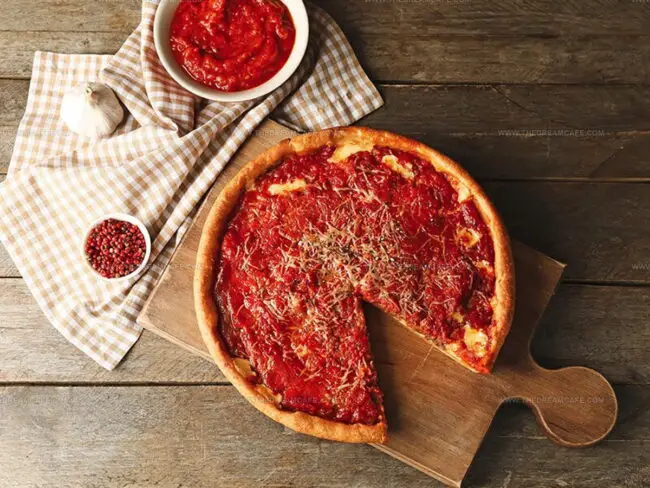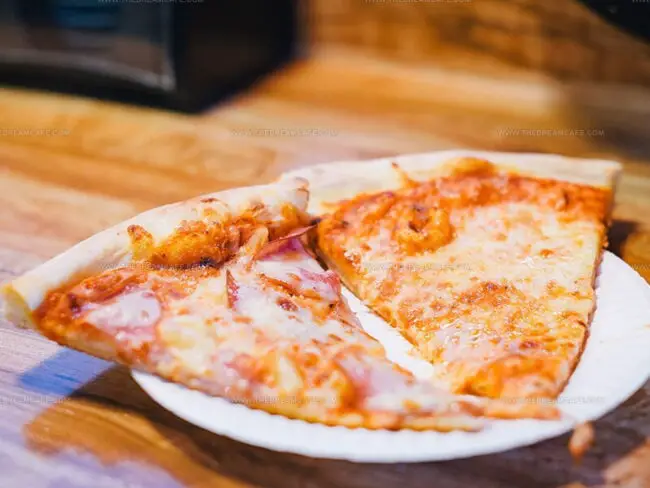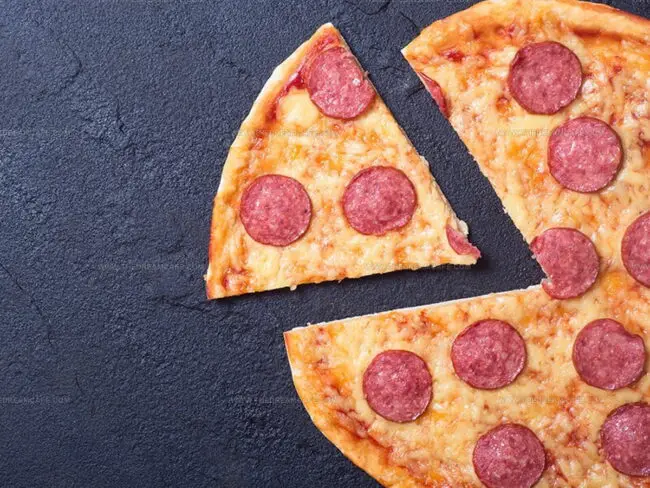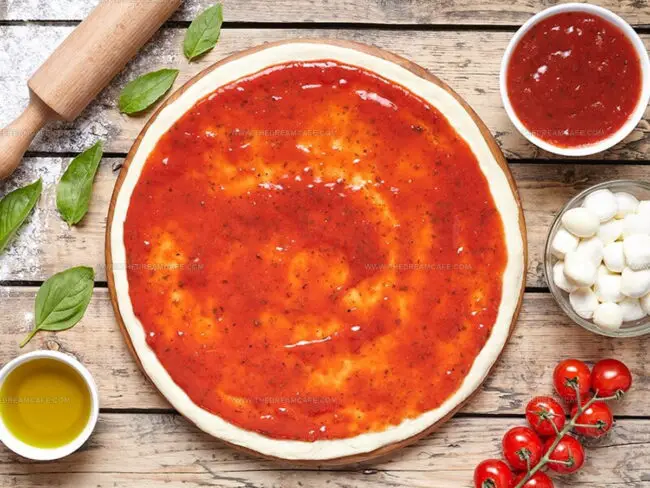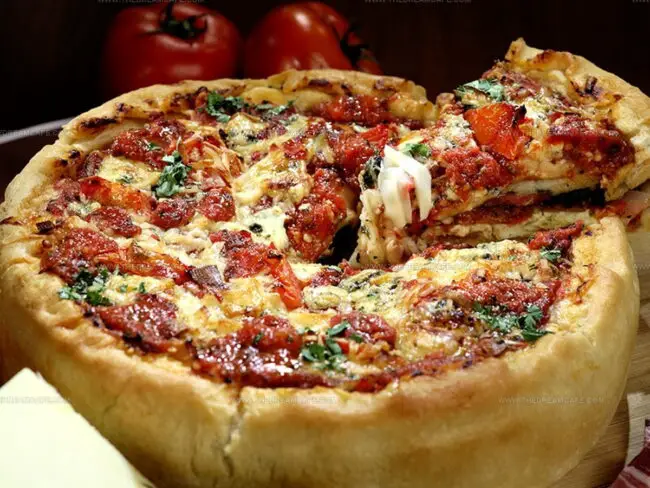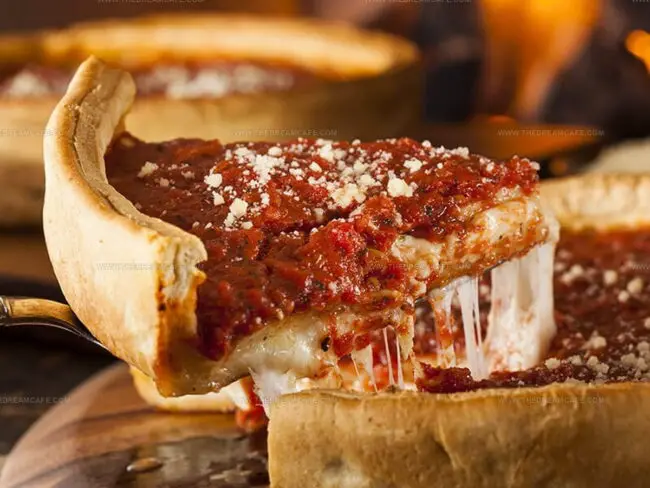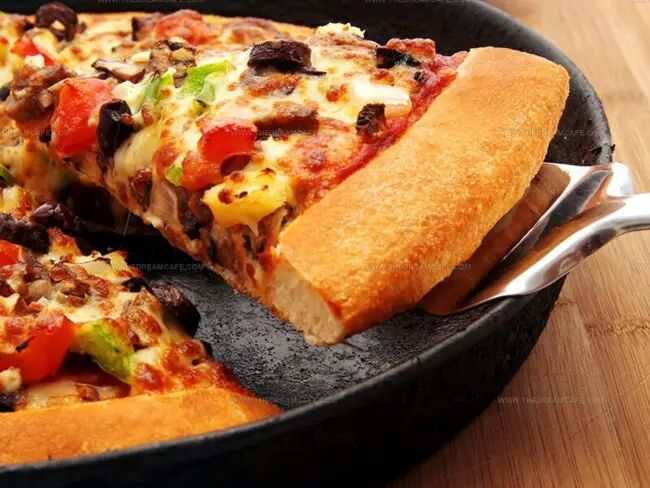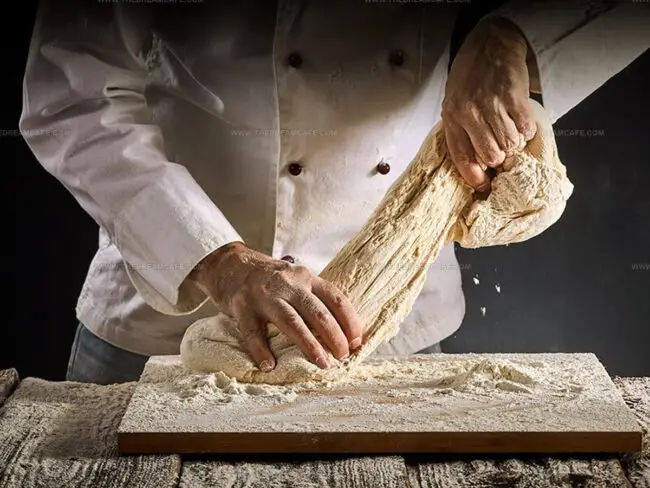New York or Chicago Pizza: Which Style Reigns?
Pizza styles from New York and Chicago have passionate fans across the nation.
Iconic approaches represent completely different philosophies about what makes the perfect slice.
New York offers thin, foldable pieces with minimal toppings, while the Windy City presents deep-dish pies that resemble savory cakes filled with cheese and sauce.
The east coast version emphasizes simplicity and tradition, allowing the basic ingredients to shine through without overwhelming complexity.
Meanwhile, midwestern pizza celebrates abundance with its knife-and-fork approach to the beloved dish.
Each city fiercely defends its creation as the ultimate expression of this Italian-American favorite.
The fascinating battle between these regional specialties reveals much about American food culture and how deeply pizza has become embedded in our national identity.
Which side will you favor after learning about their distinctive qualities?
Pizza’s Journey in America
Pizza has deep roots in American food history, dating back to Naples, Italy, in the 18th or early 19th century. The concept began as simple flatbread with toppings, then evolved as ingredients like tomatoes and mozzarella were added until it reached the form we know today.
For Italian workers, pizza served as affordable nourishment that met their daily needs. When Italian immigrants brought this dish to America's Northeast coast in the 20th century, people quickly fell in love with it.
The popularity of pizza spread even faster when American soldiers returned home after fighting in Italy during World War II, sharing their newfound appreciation for this delicious meal with family and friends across the country.
The Story Of Pizza In Chicago
Italian immigrants came to Chicago in the early 20th century seeking new opportunities, bringing their rich culture and delicious food with them. In 1943, two Italian entrepreneurs, Ike Sewell and Riccardo, took a chance by opening Pizzeria Uno on Chicago's Northside.
Their creative twist on traditional Italian pizza resulted in the now-famous deep-dish pizza - an upside-down creation with crust on top and toppings at the bottom. People fell in love with this unusual approach, helping Pizzeria Uno grow into a global franchise with locations worldwide.
Deep-dish pizza has remained a beloved part of Chicago's food identity ever since, showing how immigrant traditions can evolve into local treasures. Looking back at the colorful history of Chicago pizzas reveals how food connects cultures and becomes part of a city's heart.
The Story Of Pizza In New York
New York marks the birthplace of pizza's American journey, where ambitious Italians first introduced their specialty to the bustling city. Lombardis, established in 1905, stands as one of the earliest and most iconic pizzerias in the US.
What began as a favorite among Italian immigrants soon transformed into a fast food sensation as pizza's popularity soared. This historic establishment holds the title of America's first pizzeria and continues to serve customers today, despite temporarily closing its doors during the 1980s and 1990s.
Doughy Delight: NY and Chicago Pizza Comparison
Pizza styles from New York and Chicago stand worlds apart, with differences so striking that visitors from either city might feel shocked when tasting the other's specialty.
This table will give a quick review about their differences.
| Feature | New York Pizza | Chicago Pizza |
| Crust | Thin, crispy, flexible yet sturdy; easy to fold and eat on the go. Resembles traditional Italian pizza. | Thick, deep-dish crust, bowl-shaped, about an inch or more thick, packed with ingredients. Requires knife and fork to eat. |
| Cheese | Grated low-moisture mozzarella, finely spread in a thin layer for easy melting. | Multiple thick layers of various cheeses; very rich and sometimes greasy. |
| Sauce | Heavily seasoned tomato sauce with sweet and spicy notes; smooth and thin to preserve crust crispiness. | Chunky tomato sauce with visible tomato pieces; used in large amounts; milder flavor than New York. |
| Toppings | Light, delicately layered toppings; limited due to thin crust size. | Multiple layers of toppings (2-3 or more), with common use of Chicago-style sausage. |
| Oiliness | Quite oily; oil often leaks and may require blotting. | Less oily on surface; extra oil absorbed or cooked off during baking. |
| Cooking Time & Layers | Cooks quickly like a regular pizza; layers from bottom up: dough, sauce, cheese, toppings. | Longer cooking time (~30-40 mins); layers arranged dough, cheese, toppings, sauce on top to prevent burning. |
| Cooking Style | Dough tossed and stretched by hand; cooked on a flat surface or pizza stone. | Dough pressed into a pan/skillet, creating thick crust and walls; some have dough on top (stuffed). |
| Serving & Presentation | Sliced into large triangles; easy to hold and eat by hand; ideal for quick meals. | Served as a whole pie; eaten with knife and fork; a more filling, sit-down meal experience. |
Pizza Crust
Pizza experts can tell where a pizza comes from just by examining the crust, which varies greatly between New York and Chicago styles. These different crusts divide pizza fans into two camps - those who prefer thin crusts and those who love thick ones.
New York pizza features a thin, crispy yet flexible crust that stands up well to folding, making it perfect for busy New Yorkers who need to eat on the move. This style closely resembles traditional Italian pizza, allowing people to experience authentic flavors with minimal fuss.
Chicago pizza offers a completely different experience with its deep-dish style and inch-thick crust shaped like a bowl to hold more toppings. Many people consider the crust the main difference between these two iconic styles.
For crust lovers, Chicago pizza is a dream come true, though it might overwhelm those who aren't crust fans. Unlike its New York counterpart, Chicago pizza demands that you slow down and savor the experience.
Cheese Used In Pizza
Cheese plays a crucial role when comparing different pizza styles - it can often make or break your pizza experience. New York pizzas typically feature grated mozzarella, sometimes in more generous amounts than Neapolitan versions, though the low-moisture variety lacks freshness.
The thin, evenly distributed cheese layer on New York slices allows flavors to blend smoothly as you eat. Chicago-style pizza, however, takes a more dramatic approach with multiple thick layers of various cheeses that true cheese enthusiasts adore.
Those substantial cheese layers sit perfectly in Chicago's deep bowl-shaped crust, which was specifically designed to hold massive amounts of toppings. Many critics of Chicago pizza point to these hefty cheese layers as a downfall, claiming they make the pizza unnecessarily heavy and oily.
The difference between these cheese approaches truly shows how these two iconic pizza styles represent completely different pizza philosophies.
Pizza Sauce
New York pizza captures authentic Italian flavors with its well-seasoned tomato sauce, offering both sweet and spicy notes in each bite. Its thin crust pairs perfectly with a light layer of smooth sauce that spreads evenly without making the bottom soggy.
Chicago-style pizza takes a different approach with generous amounts of chunky sauce that sometimes contains actual tomato pieces. The deep dish needs this extra sauce to balance out its thick crust.
Most people notice that Chicago sauce has a milder flavor compared to the more intense New York version. Both styles have loyal fans who appreciate the distinct sauce-to-crust ratio that makes each pizza experience unique.
Pizza Toppings
New York pizza has toppings carefully arranged in layers on its signature thin triangle slices, which naturally limits ingredient overload - exactly how locals prefer it. Chicago pizzas take the opposite approach with multiple generous layers stacked above the cheese, often including at least two or three distinct topping levels packed with ingredients.
Sausage appears on both styles but with notable differences; Chicago versions deliver consistent flavor in every bite, while New York varieties come as spicy little meatballs or chunks scattered throughout.
Oil Used in Pizza
New York and Chicago pizzas differ greatly in how greasy they are. New York slices often drip with so much oil that many people reach for napkins to blot away the excess before eating.
In contrast, Chicago-style pizza stays much cleaner on the plate since any extra oil drains away during its longer baking time in the deep dish. This less messy eating experience can be a relief for anyone worried about oil spots on their clothes - no more stains to wash out after enjoying your pizza dinner.
Time Of Cooking And Order Of Layers
Waiting times at Chicago pizza spots can stretch much longer than in New York due to significant preparation differences. Chicago's deep dish requires extensive cooking because of its thick crust and abundant ingredients stacked in a specific order.
The layering technique sets these styles apart - New York pizza follows the classic pattern with dough at the bottom, then sauce, cheese, and toppings on top. Chicago pizza makers cleverly reversed this approach by placing cheese directly on the dough, followed by toppings, with uncooked sauce covering everything as the final layer.
This smart arrangement protects inner ingredients from burning during the lengthy baking time. Such structural differences explain why Chicago pizza fans need more patience while their hearty, layered creation bakes to perfection.
Style Of Cooking
New York and Chicago pizzas differ greatly in their preparation methods. Pizza chefs in New York showcase their artistry through impressive dough tossing and stretching techniques that captivate onlookers.
Their skilled movements transform simple ingredients into a masterpiece worth watching. Chicago-style pizza, on the other hand, requires a completely different approach.
Chefs place the dough into deep pans or skillets, carefully working it up the sides to create that signature thick crust which gives deep-dish pizza its name. Some varieties of Chicago pizza even feature an additional layer of dough on top, earning them the nickname "stuffed pizzas" among food enthusiasts.
These contrasting methods highlight why each style maintains such devoted fans across the country.
Serving And Presentation
New York pizza slices come in large triangles, perfect for grabbing with your bare hands while rushing to work. Many people simply snatch a slice and jump in their car without any hassle, making this pizza feel like a quick, on-the-go snack.
Chicago pizza, however, requires a different approach entirely. The experience demands more elegance and patience to fully enjoy, as each serving typically comes with a knife, fork, and napkins for proper dining.
Eating Chicago-style pizza resembles consuming an entire pie rather than just a slice. All that thickness and those generous toppings will keep your stomach satisfied for hours, unlike its more portable New York counterpart.
How to Make New York Style Pizza vs. Chicago Style Pizza at Home
When you need a tasty pizza at home, you can try to make these. Here are quick guide for homemade pizza.
New York Style Pizza
To make New York style pizza at home, start with a thin, high-gluten dough that is stretched thin and hand-tossed to create a flexible yet sturdy crust. Use simple ingredients, high-quality tomato sauce seasoned with oregano and basil, a light layer of low-moisture mozzarella cheese, and minimal toppings to keep it balanced.
Bake the pizza on a pizza stone or steel at a high temperature (around 500°F or 260°C) for a short time, typically 8-12 minutes, to achieve a crisp, foldable crust with bubbly, melted cheese. The key is a quick bake to maintain that classic thin crust texture and avoid sogginess.
Chicago Style Pizza
Chicago style pizza, especially the deep-dish variety, starts with a buttery, thick dough that is pressed into a deep, round pan to create high crust walls. Layer the cheese first directly on the dough, followed by generous amounts of toppings like sausage or vegetables, and finish with a chunky tomato sauce on top.
The pizza is baked at a moderate temperature (around 425°F or 220°C) for a longer time, typically 30 to 40 minutes, to allow the thick crust to cook through and the flavors to meld. The result is a hearty, pie-like pizza with a crisp, golden crust and rich, saucy filling that requires eating with a knife and fork.
Got Questions? We’ve Got Solutions
1. Where did New York and Chicago-style pizza originate?
New York pizza originated in the early 1900s when Italian immigrants brought their thin-crust recipes to Manhattan, while Chicago deep dish was created in 1943 at Pizzeria Uno by Ike Sewell.
2. Can I make New York or Chicago-style pizza at home?
Yes! New York pizza requires high-gluten flour and minimal toppings, baked in a very hot oven. Chicago deep dish needs a special deep pan, cornmeal in the dough, and longer baking time due to its thickness.
3. Which pizza style has more calories?
Chicago deep dish typically has more calories due to its thick crust, generous cheese layer, and abundant toppings. A single slice can contain twice the calories of a New York slice.
4. How should you eat each type of pizza?
New York pizza is traditionally folded in half lengthwise and eaten by hand, while Chicago deep dish is so thick it's typically eaten with a knife and fork.

